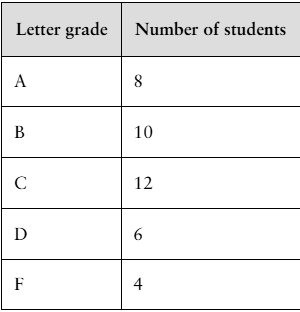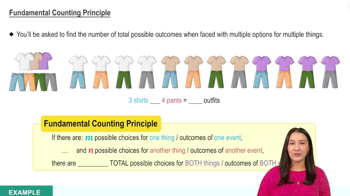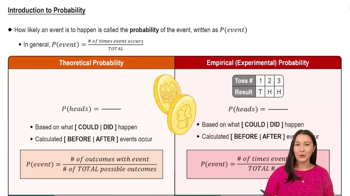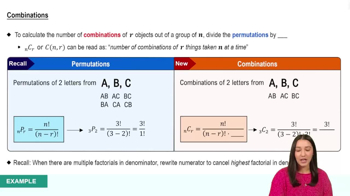56. Defective Disks A pack of 100 recordable DVDs contains 5 defective disks. You select four disks. What is the probability of selecting at least three non defective disks?
Table of contents
- 1. Intro to Stats and Collecting Data1h 14m
- 2. Describing Data with Tables and Graphs1h 55m
- 3. Describing Data Numerically2h 5m
- 4. Probability2h 16m
- 5. Binomial Distribution & Discrete Random Variables3h 6m
- 6. Normal Distribution and Continuous Random Variables2h 11m
- 7. Sampling Distributions & Confidence Intervals: Mean3h 23m
- Sampling Distribution of the Sample Mean and Central Limit Theorem19m
- Distribution of Sample Mean - Excel23m
- Introduction to Confidence Intervals15m
- Confidence Intervals for Population Mean1h 18m
- Determining the Minimum Sample Size Required12m
- Finding Probabilities and T Critical Values - Excel28m
- Confidence Intervals for Population Means - Excel25m
- 8. Sampling Distributions & Confidence Intervals: Proportion1h 12m
- 9. Hypothesis Testing for One Sample3h 29m
- 10. Hypothesis Testing for Two Samples4h 50m
- Two Proportions1h 13m
- Two Proportions Hypothesis Test - Excel28m
- Two Means - Unknown, Unequal Variance1h 3m
- Two Means - Unknown Variances Hypothesis Test - Excel12m
- Two Means - Unknown, Equal Variance15m
- Two Means - Unknown, Equal Variances Hypothesis Test - Excel9m
- Two Means - Known Variance12m
- Two Means - Sigma Known Hypothesis Test - Excel21m
- Two Means - Matched Pairs (Dependent Samples)42m
- Matched Pairs Hypothesis Test - Excel12m
- 11. Correlation1h 6m
- 12. Regression1h 50m
- 13. Chi-Square Tests & Goodness of Fit1h 57m
- 14. ANOVA1h 57m
4. Probability
Counting
Problem 3.R.52b
Textbook Question
In Exercises 49-53, use counting principles to find the probability.
52. A class of 40 students takes a statistics exam. The results are shown in the table at the left. Three students are selected at random. What is the probability that
b. all three students received a C or better?

 Verified step by step guidance
Verified step by step guidance1
Step 1: Identify the total number of students in the class. From the table, sum the number of students across all letter grades: A (8), B (10), C (12), D (6), and F (4). This gives a total of 40 students.
Step 2: Determine the number of students who received a grade of C or better. From the table, grades A, B, and C are considered 'C or better.' Add the number of students in these categories: A (8), B (10), and C (12). This gives a total of 30 students.
Step 3: Calculate the total number of ways to select 3 students from the class. Use the combination formula \( \binom{n}{r} = \frac{n!}{r!(n-r)!} \), where \( n \) is the total number of students (40) and \( r \) is the number of students to be selected (3).
Step 4: Calculate the number of ways to select 3 students who received a grade of C or better. Again, use the combination formula \( \binom{n}{r} \), where \( n \) is the number of students who received C or better (30) and \( r \) is the number of students to be selected (3).
Step 5: Find the probability that all three selected students received a grade of C or better. Divide the number of favorable outcomes (from Step 4) by the total number of outcomes (from Step 3). The formula for probability is \( P = \frac{\text{favorable outcomes}}{\text{total outcomes}} \).
 Verified video answer for a similar problem:
Verified video answer for a similar problem:This video solution was recommended by our tutors as helpful for the problem above
Video duration:
3mPlay a video:
Was this helpful?
Key Concepts
Here are the essential concepts you must grasp in order to answer the question correctly.
Counting Principles
Counting principles, such as the fundamental counting principle, help determine the number of ways to choose or arrange items. In this context, it is essential for calculating the total number of combinations of students that can be selected from the class. Understanding how to apply these principles allows for accurate probability calculations based on the number of favorable outcomes versus total outcomes.
Recommended video:

Fundamental Counting Principle
Probability
Probability is a measure of the likelihood that a particular event will occur, expressed as a ratio of favorable outcomes to total possible outcomes. In this scenario, the probability of selecting three students who received a C or better involves determining how many students fall into that category and how many ways they can be selected. This concept is fundamental for quantifying uncertainty in statistical analysis.
Recommended video:

Introduction to Probability
Combinations
Combinations refer to the selection of items from a larger set where the order does not matter. In this problem, we need to calculate the number of ways to choose three students from those who received a C or better. The combination formula, denoted as nCr, is crucial for determining how many different groups of students can be formed, which directly impacts the probability calculation.
Recommended video:

Combinations

 7:11m
7:11mWatch next
Master Introduction to Permutations with a bite sized video explanation from Patrick
Start learningRelated Videos
Related Practice
Textbook Question
